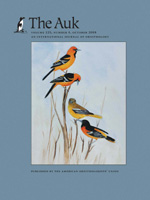We analyzed the seasonality of molt of African Penguins (Spheniscus demersus) in adult plumage and used information derived from banded individuals to examine the relationship between age, breeding status, and timing of molt in Namibia. Molt seasonality was bimodal, with a major molt peak in the austral autumn and a minor peak in midsummer. African Penguins younger than four years—and, therefore, unlikely to be sexually mature—molted in early January, at the same time as juvenile African Penguins. Birds aged between four and six years molted either in summer or autumn and were likely to be individuals making the transition from nonbreeder to breeder. African Penguins older than six years, considered to be breeders, molted, on average, in early May. Most birds that had been recorded breeding within 12 months of molt molted between March and May. Summer breeding in Namibia appears to force breeders to delay molt until autumn. There was individual variation in molt seasonality that we could not explain by age alone. Estimates of the proportion of potential breeders in the population derived from molt phenology and from the molt histories of banded, known-age individuals were likely to be underestimates and suggested that some adults of breeding age defer breeding.
How to translate text using browser tools
1 October 2008
Effect of Age and Breeding Status on Molt Phenology of Adult African Penguins (Spheniscus Demersus) in Namibia
Jessica Kemper,
Jean-Paul Roux,
Les G. Underhill
ACCESS THE FULL ARTICLE

The Auk
Vol. 125 • No. 4
October 2008
Vol. 125 • No. 4
October 2008
African penguin
age
breeding activity
demography
molt
seabird
Seasonality




